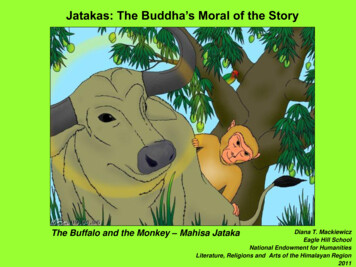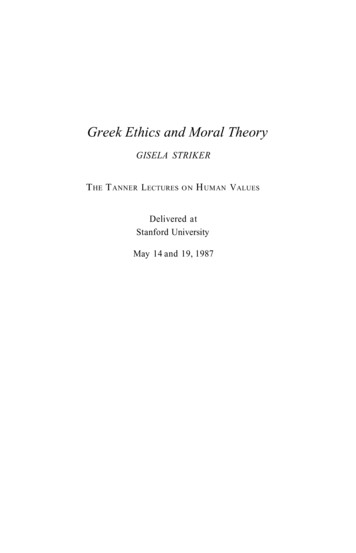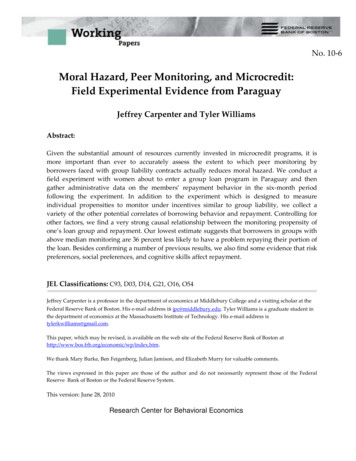
Transcription
Jatakas: The Buddha’s Moral of the StoryThe Buffalo and the Monkey – Mahisa JatakaDiana T. MackiewiczEagle Hill SchoolNational Endowment for HumanitiesLiterature, Religions and Arts of the Himalayan Region2011
How old is Buddhism?Where was theBuddha born?The Buddhist Canon as it existtoday was settled at this Counciland preserved as an oraltradition.5th Century B.C.E.NepalHow many people in the worldare Buddhists?350 Million , fourth largestreligion in the worldWho is the founderof Buddhism?Siddhartha Guatama, thehistorical Buddha:conventional dates: 566-486B.C.E. (According to morerecent research, reviseddates are: 490-410 BCE).What are jatakas?Jatakas are Buddha’s birthstories and there are about500 stories.
“The Jatakas are Buddhist parables and tales –loose parallels of the Panchatantra. They tell thetales of Buddha in his previous lives (when he wascalled Bodhisattva or Buddha-to-be), which includedincarnations in the form of a snake, a tiger and evenan elephant. These stories reflect the travails andexperiences that he had to go through to attain thewisdom of the lIndia Site
“Panchatantra: (Sanskrit: Five Books), famous Indiancollection of fables and other morally instructive tales. ThePanchatantra belongs to the literary genre of mirror forprinces, intending to teach wisdom to future rulers. Its fivebooks treat the following topics: (1) disunion of friends, (2)gaining of friends, (3) war and peace, (4) loss ofpossession, (5) consequence of rash action. The author ofthe Panchatantra is unknown.”Examples ofcurrentPanchatantrastory books.“Panchatantra." The Oxford Companion to Fairy Tales. Oxford University Press, 2000, 2002,2005. Answers.com 12 Jan. 2008. http://www.answers.com/topic/panchatantra
Why teach Jatakas? Teaching the Jatakas as Buddha told them is nearlyimpossible, but learning them is still interesting and useful.Buddha taught his disciples the Jatakas as a means to illustrate the travailsthat each one experiences in their life and the lessons to be learned.Often learning the Four Noble Truths and the Eightfold Path were daunting.But to have a concrete moral or lesson explained via one of the Jatakashelped the new disciple further grasp the meaning of the story: the moral.Therefore, when reading the Jatakas, it is helpful to ask: What was the moralor lesson of the story? Which precept was the lesson in the lifetime of theBodhisattva?Learning the Jatakas of Buddha is like reading Aesop's fables or one of themany Panchatantra.An illustrationfor the jataka:Self-Sacrifice.
The Five Precepts of BuddhismNot everyone could become a monk or nun, devoting their life tostudy and meditation. The Five Precepts were the minimumobligations for monks and laypeople. They also answer thequestion: “What should I do to lead a good life and to achieveliberation from rebirth?” Do not kill anything (human, beast or bug) It is worse to killlarger animals because more force is involved. Do not steal or take anything that belongs to others. Preventothers from profiting from human suffering or the suffering of otherspecies on earth. Do not engage in sexual misconduct. Do not lie, speak poorly of others, or gossip. Practice lovingspeech and active listening. Do not use alcohol and recreational drugs.From Silk to Oil: Religions along the Silk Roads
Useful Buddhist terms to know:Bodhisattva : A Buddhist saint, someone who lived on earth and knowingly gaveup a chance for Nirvana in order to help others on earth.Nirvana: from the root 'nirva', to blow out, extinguish. Hence, when all desiresand passions are extinguished the highest bliss or beatitude, reunion with theSupreme Spirit, may be experiencedDharma: This is the universal truth common to all individuals at all times, and itis regarded as one of the primary sources of Buddhist doctrine and practice.Karma: The law of Karma ensures accountability for every thought, action andword. Each has an effect on this and future lives.The Sleeping Buddhaon his way to Nirvana.
JatakasAesop’s FablesBuddhist literary tradition;predominantly influenced byIndian-Asian culture andgeography.Ancient Greek Literarytradition: predominantlyinfluenced by morals ofWestern society, and thePanchatantras.Law of Karma controls thereincarnation of anysentient being.Cause & Effect explains themoral of the story andduality in each character.Historical teaching tool used Aesop(620–560BCE),Greekby Buddha (490-410 BCE)slave used the parables asfor disciples.teaching tools.His existenceis still controversial!Aesop's fables and the Panchatantra share about a dozen tales,leading to discussions whether the Greeks learned these fablesfrom Indian storytellers or the other way, or if the influences weremutual.
Use Wisdom, Don’t RushWhat do the monkeys appear to be doing?What does the blue monster represent to you?Jataka
The Lion & The RabbitA Fable from IndiaThe animals of the forest made a bargain with a ferocious lion who killed for pleasure. Itwas agreed that one animal each day would willingly come to the ferocious lion's den tobe his supper and, in turn, the lion would never hunt again. The first to go to the lion's denwas a timid rabbit, who went slowly."Why are you late?" the lion roared when the rabbit arrived."I'm late because of the other lion," said the rabbit."In my jungle? Take me to this other lion."The rabbit led the lion to a deep well and told him to look in. The lion saw his ownreflection in the water and roared! The sound of his roar bounced right back at him as anecho."I alone am king of this jungle," he roared again.His echo answered him, "I alone am king of this jungle."With that, the lion became so enraged, he charged into the deep well with a great splash!The lion attacked his own reflection and was never heard from again.Example of a Panchatantra that is similar to the Aesop fable of The Jackal and l/stories/lion.html
The Phony Holy ManA Jataka tale abouthypocrisy!See handout.
The Ant and the ChrysalisAn Ant nimbly running about in the sunshine in search of food came across aChrysalis that was very near its time of change. The Chrysalis moved its tail,and thus attracted the attention of the Ant, who then saw for the first time that itwas alive. "Poor, pitiable animal!" cried the Ant disdainfully. "What a sad fate isyours! While I can run hither and thither, at my pleasure, and, if I wish, ascendthe tallest tree, you lie imprisoned here in your shell, with power only to move ajoint or two of your scaly tail." The Chrysalis heard all this, but did not try tomake any reply.A few days after, when the Ant passed that way again, nothing but the shellremained. Wondering what had become of its contents, he felt himself suddenlyshaded and fanned by the gorgeous wings of a beautiful Butterfly. "Behold inme," said the Butterfly, "your much-pitied friend! Boast now of your powers torun and climb as long as you can get me to listen." So saying, the Butterfly rosein the air, and, borne along and aloft on the summer breeze, was soon lost tothe sight of the Ant forever."Appearances are deceptive."Compare this Aesop’s Fable to theJataka of the Phony Holy AntandtheChrysalis
Internet resources used: direct links towebsites.Aesops’ Fables Online CollectionAnimal gifsBuddhist studiesIndia SiteSakyamuni Sambuddha Vihara & Buddhist Vihara VictoriaIncStories in a NutshellWorld Tales
Jataka Class Activity Background information on Buddhist faith and origins is essential.Buddha was a person and the word “buddha” means enlightened one. Introduce the Five Precepts as the main points for each jataka as told byBuddha. Explain Reincarnation and Karma as taught by the Buddhist. Discuss morals that are taught at home and in public places like schoolor places of worship. Introduce the Jatakas and their connection to reincarnation and morals. Introduce the Panchatantras, because there is a cultural connection inIndia. Introduce Aesop’s Fables. Read aloud the book, I Once Was a Monkey by Jeanne M. Lee Thepictures are excellent to show students. Older students (gr. 9-12) would be well served by the resource,Jatakas: Birth Stories of the Bodhisatta by Sarah Shaw.
Homework assignment : read a short Jataka,The Wind and the Moon and identify who theBodhisattva was, the moral of the story andtheme of the story. This is a preview as to howwell students grasp the idea of the story. Visit some of the websites given to find theJatakas suitable for your class to read. Print out copies of several of the stories anddelete the images from the stories if they areillustrated. If possible, try to provide a largeamount of diversity in the moral topics covered. Illustrate, act out or rewrite a new ending: allfocusing on the precept presented and the moralof the story.
Texts used
Texts Used
“The Jatakas are Buddhist parables and tales – loose parallels of the Panchatantra. They tell the tales of Buddha in his previous lives (when he was called Bodhisattva or Buddha-to-be), which included incarnations in the form of a snake, a tiger and even an elephant. These stories reflect the travails and experiences that he had to go through to attain the wisdom of the Buddha.” www .











